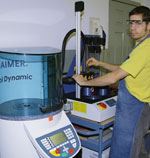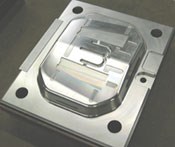Tool Balancing and Shrink-fit Holders Yield Successful Manufacturing Platform Overhaul
Investing in technology while improving processes and methods yields near 100 percent success rate on initial mold trials and 50 percent reduction in shop rework and scrap.
Foresight, advanced technology and attention to detail are not only keeping Tri-Star Mold (Cambridge, ON) viable in today’s rough economic environment, but also making it a leader in its field. Tri-Star Mold was founded in 1997 by three partners—two moldmakers and one mold designer—to design and build small- to medium-sized molds for all markets. Today, Tri-Star has proven experience needed to ensure success with each production mold—from demanding high-tech automotive applications to medical cleanroom molding. The company has developed a niche for demanding applications that require out-of-the-box mold design and manufacturing.
The Overhaul
Three years ago, Tri-Star decided to upgrade everything about its manufacturing platform and has since achieved a near 100 percent success rate on initial mold trials and has eliminated at least 50 percent of its scrap or rework.
“Whatever margin leeway we had years ago has disappeared,” says Pete Florica, Tri-Star’s GM. “By staying focused, keeping lean, investing, improving processes and methods, we’ve been able to cut costs in other areas to offset what we’re losing in margins to remain viable.”
Technology Investment
After evaluating its entire manufacturing process, Tri-Star decided to purchase two Makino vertical milling machines—a 30,000-rpm V33 and a 20,000-rpm S56 model; Camtool software; and, a Power Clamp shrink-fit machine and a Tool Dynamic balancer from Haimer USA. Tri-Star also looked to Haimer for its shrink-fit chuck toolholding needs and uses all high-performance carbide cutters from a variety of manufacturers.
“We monitor our success rate since the platform change by percentage of success on initial mold trial, where we’re above 95 percent,” says Dave Tomic, Tri-Star’s CNC manager. “We also monitor shop floor rework and scrap rates, which have been dramatically reduced, by at least 50 percent, since the platform change.”
Measuring
Tri-Star uses high-accuracy measuring microscopes to inspect every mold detail or component after they are cut. “In addition to the microscope measuring, critical sizes also are verified as moldmakers perform downstream operations such as EDM, finish grinding and fitting,” Florica says. “This method ensures at least two or more individuals have validated a component prior to assembly. After assembly, every mold goes through a checklist to ensure all customer specifications have been met.”
Balancing
“When you start running at high rpms, and your balance is off, you run the risk of premature spindle bearing failure,” says Tomic. “Balance is tremendously critical to the integrity of your spindle bearings and the better the integrity of your spindle bearing, the better the finish, tool life and spindle life you will get. When you run that fast, balancing dynamics change dramatically.”
Balancing, according to Tomic, reduces harmonic chatter, which improves the finish, and helps when Tri-Star reaches into its toolbox for its longer tools.
Haimer’s additional contribution to Tri-Star’s platform change—shrink-fit toolholders and a shrink-fit machine—increased rigidity of the tools and significantly reduced runout. “There’s a high level of concentricity between the tools and the spindle center with the shrink-fit holders,” Tomic says. “The tools run very, very accurately.”
Tri-Star says it selected the Haimer shrink-fit system because of its weighted set-screw balancing method, adding that it’s accurate and very repeatable through the entire manufacturing process. “They don’t come loose and they don’t change on you during machining,” Tomic notes.
Tomic adds that the balancer was acquired mostly as an insurance policy on its spindle bearings, but acknowledges that the Haimer balancer together with Haimer’s shrink-fit system is paying actual benefits. “The system really pays off in accuracy predictability,” he says. “We do a lot of unattended cutting and when you come in the following morning, you know what has been cut is what you expect.”
Good Positioning
The change to the new platform three years ago has put Tri-Star Mold in a good position to not only deal with the challenging economic times facing North America, particularly in the automotive industry, but to differentiate itself among its competitors.
Related Content
How to Eliminate Chatter
Here are techniques commonly used to combat chatter and guidelines to establish a foundation for optimizing the moldmaking process.
Read MoreFundamentals of Designing the Optimal Cooling System
The right mold components can help improve mold cooling and thereby produce higher-quality parts.
Read MoreLaser Welding Versus Micro Welding
The latest battle in finely detailed restoration/repair of mold materials.
Read More6 Ways to Optimize High-Feed Milling
High-feed milling can significantly outweigh potential reliability challenges. Consider these six strategies in order to make high-feed milling successful for your business.
Read MoreRead Next
Are You a Moldmaker Considering 3D Printing? Consider the 3D Printing Workshop at NPE2024
Presentations will cover 3D printing for mold tooling, material innovation, product development, bridge production and full-scale, high-volume additive manufacturing.
Read MoreHow to Use Strategic Planning Tools, Data to Manage the Human Side of Business
Q&A with Marion Wells, MMT EAB member and founder of Human Asset Management.
Read MoreReasons to Use Fiber Lasers for Mold Cleaning
Fiber lasers offer a simplicity, speed, control and portability, minimizing mold cleaning risks.
Read More









.png;maxWidth=300;quality=90)


















